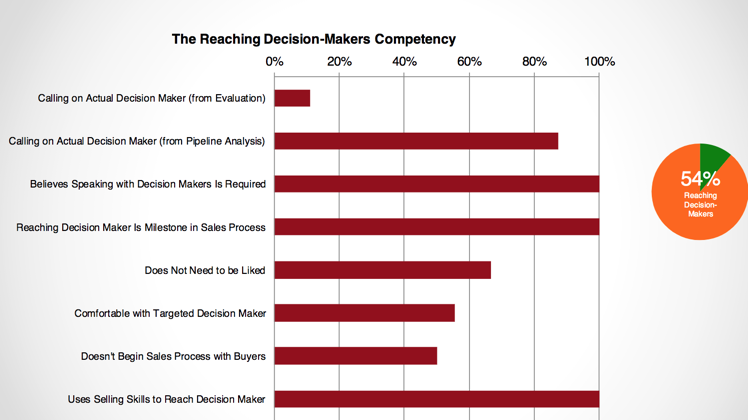- April 30, 2018
- Posted by: Dave Kurlan
- Category: Understanding the Sales Force

Humans have been waiting for thousands of years to discover the secrets of life. Why are we here? Why do bad things happen? What happens after we die? Is Heaven real? What is God’s plan for us?
While many experts have attempted to answer all of these questions, most of us lack proof. There’s no data. If we wake up tomorrow morning and suddenly there are not only answers to these questions, but science-based proof, that would be a game-changer for us.
Likewise, every day most companies try to determine why their salespeople don’t close more business, why so many opportunities die on the vine, and what they need to do differently to change their results. They try everything! Most leaders think it’s an issue of closing skills. It’s not. Others think it’s about prospecting. While that has an impact on the size and quality of the pipeline, it has little to do with results. But I have discovered the cause, will show you the data, and discuss how to fix it.
Recently, Objective Management Group (OMG) integrated its sales force evaluation and its pipeline analysis. Previously, the pipeline analysis was a separate chapter and while very revealing, the data was standalone. OMG also expanded its analysis of salespeople’s ability to reach decision makers and rather than a finding as it once was, it is now a full competency with 8 attributes.
I have reviewed several dozen sales force evaluations conducted since the change and discovered something very revealing. Look at the bar graph shown below:

This is VERY representative of every sales force evaluation I reviewed for this article. There is a lot going on in this graph so let me walk you through it.
This sales force averages 54% of the attributes for reaching decision makers but only 13% (green slice of the pie) are strong at this competency. The overwhelming majority of the salespeople believe in the importance of reaching decision makers and use their skills to attempt that. Let’s focus on the first two attributes which are both Calling on Actual Decision Makers but show contradicting data.

Let’s start with the second attribute. We ask each salesperson to identify 4 late-stage, proposal-ready or closable opportunities and we ask them 19 questions about each of those opportunities. Nearly 90% of the salespeople met with the actual decision makers on these late-stage opportunities. That’s pretty good.
The first attribute comes from each salesperson’s personal evaluation. It shows that only 10% of them are reaching actual decision makers overall. That’s pretty bad.
Now that we have these two opposing data points, it should be clear what the problem is, both for this company and for many of the companies showing the same contradiction.
When salespeople successfully reach the actual decision makers, opportunities move through the pipeline and reach the closable stage, often resulting in a win. However, MOST salespeople are NOT reaching the actual decision makers and those are the opportunities that lose traction and/or result in a loss.
Remember, for the most part, these are salespeople who believe it’s important to reach the decision maker, have that as a milestone in their sales process, have the sales skills to reach decision makers, but still fail to reach the decision makers.
Let’s take a closer look at a few of the other attributes.

Half of their salespeople are calling on buyers at the start of the sales process. Why are they doing that? Nearly half aren’t comfortable meeting and talking with the target decision makers, and a third need to be liked and can’t push back on buyers who won’t introduce them to or allow them to meet with decision makers.
Clearly, this is not the only problem that sales organizations are facing by a long shot. However, this data shows that if they could fix just one thing today, the consistent ability to reach decision makers would make a huge difference.
It’s one thing to know what the problem is and its impact on results. However, fixing this problem is not simple. Reaching decision makers is made possible by having advanced listening and questioning skills in an effective consultative selling process, an ability to differentiate, and being perceived as a trusted advisor. Reaching decision makers is time sensitive in that the timing must be perfect to consistently succeed at getting the decision makers to engage. Let me use my expert ability to combine baseball and sales for the perfect analogy. Have you read Baseline Selling?
If the batter swings too early he will probably miss the pitch or perhaps hit a weak ground ball. If the batter swings too late he will probably miss the pitch or perhaps hit a pop fly ball. If the batter times his swing perfectly and squares the bat to the ball he will crush it. Salespeople need to crush it when it comes to reaching decision makers. They must time their ask perfectly or they will probably strike out. You can also use comedy as an analogy where the comedy writer provides the same routine to a professional comedian and an amateur. The words coming out of each person’s mouth would be identical but the professional comedian gets the laughs because of having mastered the timing and cadence of the delivery.
This problem can be fixed but the trainer or coach providing the help must have a mastery of the nuances of how these pieces all come together. If your salespeople can reach even 25% more decision makers, think about the impact that will have on revenue.
You can see all of OMG’s data for all 21 Sales Core Competencies, by industry and even see how your company compares.
Image Copyright iStock Photos
